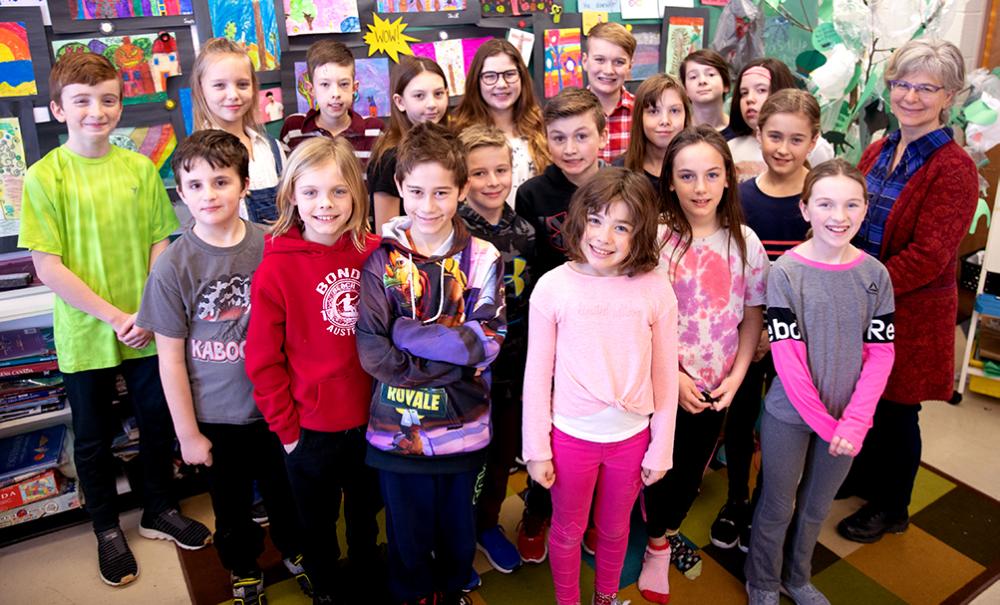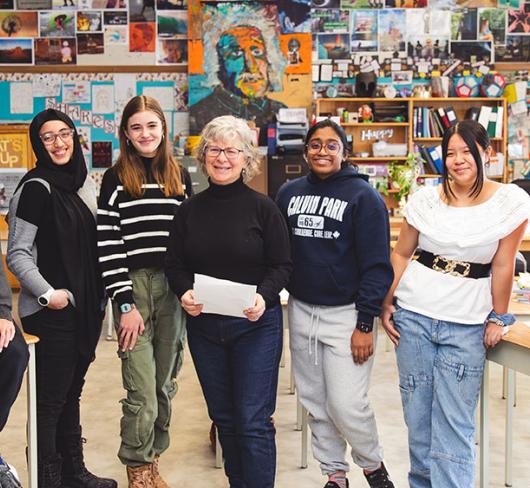
Mentoring Student Activism: From Fear to Empowerment
The grade fours and fives at my school are taking on the province of Ontario. It didn’t start all at once; it crept up on us. Perhaps the most interesting right of Canadians, they agreed, was the right to protest peacefully. “And you don’t have to wait to be an adult to exercise that right,” I said casually. Lily spoke up. “Plastic,” she announced. “We should protest all the plastic in the ocean. It’s awful. We have to do something about it.”
Talking About Bad News
There are compelling reasons why we need to teach our elementary students about what some might dismiss as “bad news.”
The reality is students are bringing the news to school. They’re anxious. They overhear conversations about wars or mass shootings. Newcomer students arrive with nightmares of bombs. We might try to shield our younger students, but many are already grappling with the issues in the hallways. When Donald Trump was elected, I had to reassure grade twos that he wasn’t going to attack us. I don’t even teach grade two. Young students need to be reassured that they are safe, that something is being done to help and that it will get better. Juniors and intermediates need and want to start helping.
Students need to know the truth, not last century’s facts from old textbooks. We must teach the latest scientific facts about global warming and the results it will bring: more severe hurricanes, flooding, tropical diseases moving north and loss of stabilizing ice at both poles. Polar bears, lost. Coastlines, swallowed up. Already the island atoll country of Kiribati is disappearing under the rising ocean.
Scientists agree that increasing the planet’s temperature by 1.5 degrees is the tipping point toward disaster. Canada signed the Paris Accord to lower fossil fuel emissions. However, last summer, Montreal’s heat wave caused over 90 deaths and B.C. wildfires made asthma medications spike in Vancouver and filled Calgary with black smoke. This is real.
I think sometimes we underestimate the strength of our students. They are capable of becoming educated activists, even world changers. Look at what young people have accomplished recently: 15-year-old Greta Thunberg scolded the United Nations. (Show that video to your class.) Nearly 10,000 Australian students demanded action on climate change. Craig Kielburger fought to end child labour at age 12. Malala Yousafzai gave her first speech at 11. William Kamkwamba, 14, unable to afford school, built a wind turbine from an old bicycle and scrap metal. Boylan Slat started his ocean clean-up project at age 16. Students can change things.
In science, our students experiment, observe and learn to think for themselves. Embedded through that curriculum is a growing understanding of air, water, soil, energy, renewable energy and how we affect the planet. In our social studies curriculum, students explore how they’re connected to their communities, Canada and the world. We challenge them to see various sides of issues, understand their rights and responsibilities and become involved citizens. Even the arts curriculum document states that one idea underlying it is “making a commitment to social justice and dealing with environmental issues.”
Building Activism Into Classroom Learning
My first class at Elginburg District P.S. wrote letters to protest the lack of a school in Attawapiskat in 2009, their response to a news article I’d shared. A pipeline laid under the school had broken, spilling 95,000 litres of diesel fuel – back in 1979. If I’d merely read this depressing news to my students, it would have added to their anxiety. I presented it as a discussion topic, a chance to look at all sides. It was also an opportunity for action, for caring for others and making change.
When Justin Trudeau walked to work on his first day with the cabinet, my students watched. The cabinet was half women and represented the different communities that make up Canada. Some members had once been refugees; one used a wheelchair. We discussed it.
When the Canadian government invited 25,000 Syrian refugees to Canada, my class made a “Welcome to Canada!” banner the length of the room.
Encouraging Questions
After I bring in the primary sources to generate discussion, I encourage questions. When enthusiasm mounts, I send them off to do research. Finally, to leave them feeling empowered, I mentor them through a class project to address the issue they feel strongly about.
Lily suggested plastic bags. The other students agreed. Former MPP, Sophie Kiwala, came in to chat with all the grade five students about government. Lily told her we were going to ask Kingston to ban plastic bags. Kiwala congratulated them, then asked, “Why only Kingston? Why not Ontario?”
That led to the grade fives researching the reasons behind banning plastic bags, how other cities were doing it, which type was wisest to target. I suggested sources that were reputable, such as the United Nations, CBC and Ecojustice reports. I steered them away from gory photos or sensational reporting. It was a mini lesson in being critical of media. They kept rushing up to me in pairs, clutching an iPad with shocking facts about the size of islands of plastic in the ocean or numbers of plastic bags used in a year.
I brought in Ontario peppers wrapped in plastic over styrofoam and a mix of takeout containers to deepen our discussions. It turned out that coloured and black plastics are not even recyclable in our area. Comparing the takeout containers available already, they voted to add styrofoam to their petition. Polystyrene is our new word.
As teachers, we must address global issues. What we choose to share will depend on our students’ age and maturity, but how we share world news is critical. I showed news footage of the 1985 Haida logging protest. Grade 5 students wrote a journal entry from each side, then chose a role and sat at a “debating table.” They each had a minute to give their point of view. The grade 4s, as the government, listened. Then the 5s left to come up with a solution, which the 4s voted on. In that case, they learned the government had decided to create a 1,500 square kilometre National Park Reserve that would protect salmon streams. Logging could continue, but at a rate agreeable to both, and the islands dropped their colonial name and became Haida Gwaii. We clapped.
We repeated the process for the contemporary issue of salmon farming, and the Tiny House Warriors, Secwepemc people protesting a pipeline crossing their alpine territory. These Canadians inspire us. In these exercises, my students have learned there are different sides to all issues, governments are imperfect and regular people can make a difference.
Engaging Your Students as Change Makers
Naomi Klein has said that we need to inspire a love of nature in children so they will become intelligent activists later on, working from a place of connection and respect. We need to take our classes into conservation areas often, let them wonder.
It is crucial to instill a reverence for nature in every child but also to foster critical thinking. You can show breaking news stories about injustices, both climate and social, as long as you also show those who fight it, those who offer hope every day and encourage your students to find a way to get engaged and help.
Climate justice and social justice are intertwined. Both are targets of right wing politics and corporate greed. In school, we’re teaching our students to rejoice in our multicultural heritage, to reject rigid thinking and prejudice and to become wise stewards of the planet. The current Ontario government closed the independent Environmental Commissioner’s office and cut funding to renewable energy projects. Issues like these are perfect to explore in class.
Which brings us to taking on the province of Ontario. Will we convince this government to ban single use plastic and polystyrene? I don’t know. But my students will have tried, valiantly, to fight for the planet. MPP Nathalie Des Rosiers has offered to present our petitions to Queens Park and table a law that my students have written. A law that my students have written. How empowering is that?
Love of our planet, joy in stewardship, empathy and caring for others, civic rights and how to stand up against injustice – that is what we need our students to learn.
Update November, 2019
Provincially, the petition was read aloud twice in the Ontario legislature by MPP Des Rosiers and the NDP, Liberal and Green members all expressed their support. The Environment Minister spoke privately with Des Rosiers and did actually show interest in this movement, if not intention. Since our petition, more studies have shown the terrible effects of plastic in our lakes and waterways. There are a couple of videos now on YouTube about the petition circulating. The best one is the short one of a few of the students speaking to Ontario. They wrote their sentences themselves and they are endearing and powerful.
Jerri Jerreat is a member of the Limestone Teacher Local.
10 Inspiring Resources:
- Greta Thunburg’s speech to the United Nations on Dec. 15, 2018. (3:21 minutes. Let your class watch it.) Then, the Australian students’ protest to demand action on Cclimate change.
- Malala Yousafzai, Boylan Slat. William Kamkwamba. Share one of Malala’s speeches with your class. Boylan Slat found there was as much plastic in the ocean as fish and began a school project to use currents to clean it up. Kamkwamba, at 14, saw a photo of windmills in an old textbook and searched the dump to build a wind generator for his family in Malawi. That was the beginning. Read “Teen’s DIY Energy Hacking Gives African Village New Hope” by Kim Zetta, Science, 10:02:09. Show his and Slat’s TED talks to your class.
- Ecojustice: see their publications and reports, and look at some cases these lawyers are working on, for us. An inspiring site to share with students – ecojustice.ca/stateof-play-climate-change-december-2018/.
- David Suzuki Foundation: check out “Climate Solutions” under “Our Work.”
- TED talk by grade 4 teacher John Hunter, “The World Peace Game.” An inspiring teacher, he presents real world problems and over the year, students come up with solutions.
- World Wildlife Canada – excellent resources for students, and fun activities to raise awareness at your school.
- Reputable websites for facts: The Columbia Institute and The Centre for Civic Governance; The Solutions Project; The United Nations; The Ellen MacArthur Foundation and a “circular economy” (U.K.).
- Speaking Our Truth: A Journey of Reconciliation by Monique Gray Smith, Orca Books, is a book you can use yourself or share with your class. It is written from a place of love and hope. Also, Limestone ETFO hosted the “Walk a Mile Film Project” set in Thunder Bay, Ontario. Find that film and watch it.
- Elginburg District Public School’s petition to ban single-use plastic bags and polystyrene across Ontario needs help. Please post, print and share the petition. Send it on to MPP Nathalie Des Rosiers at Queen’s Park. elginburg.limestone.on.ca, click on Holding the Bag.
- Your local issues. What are they? Bring in newspaper articles (or online). Open a discussion. Jot down all the issues your students have heard about or noticed in your community. On a twin sheet of chart paper, ask them to suggest ways to help with those situations. See where it leads. Then follow it.

